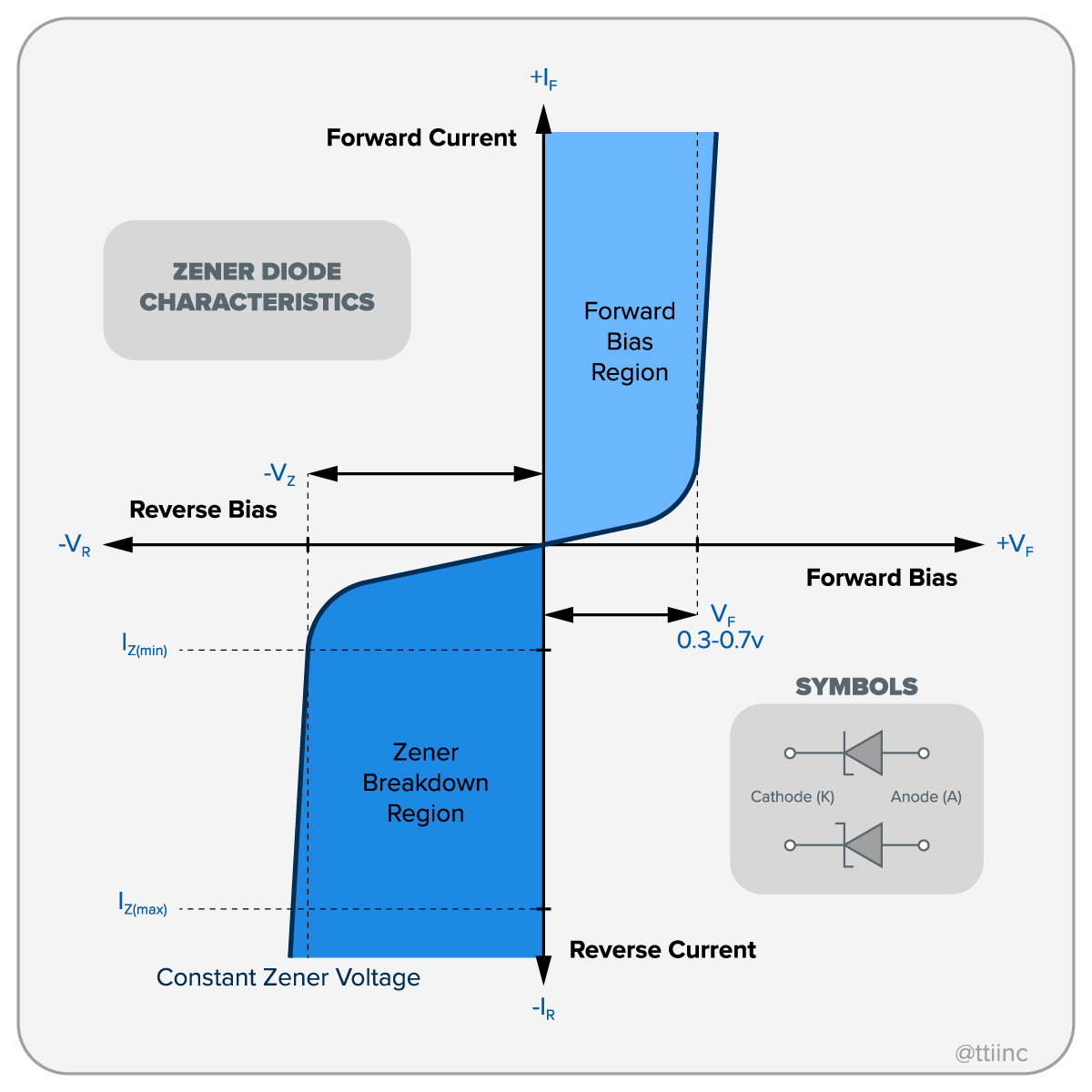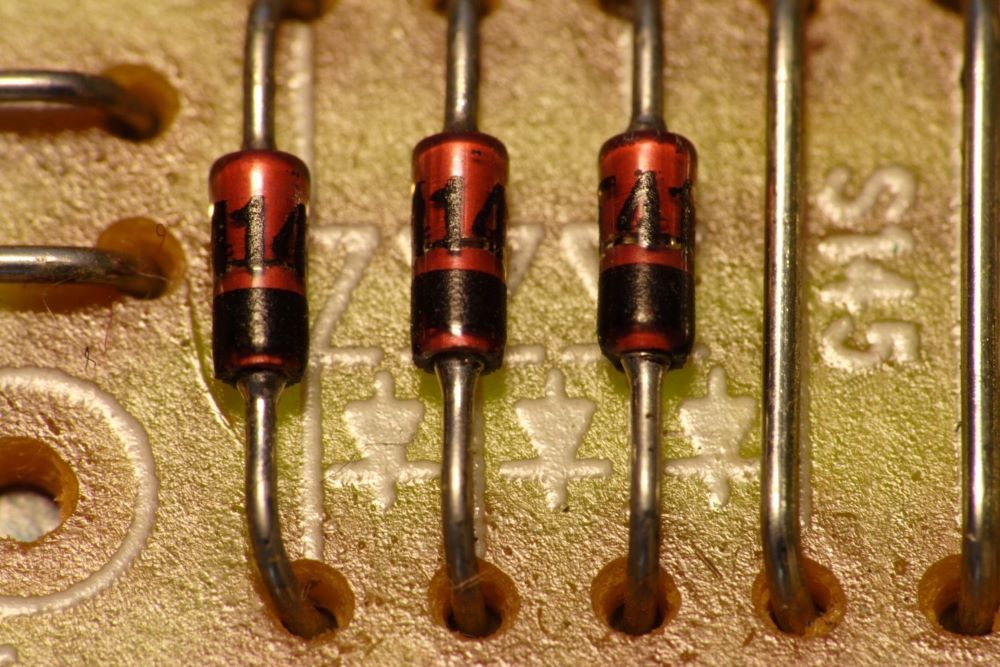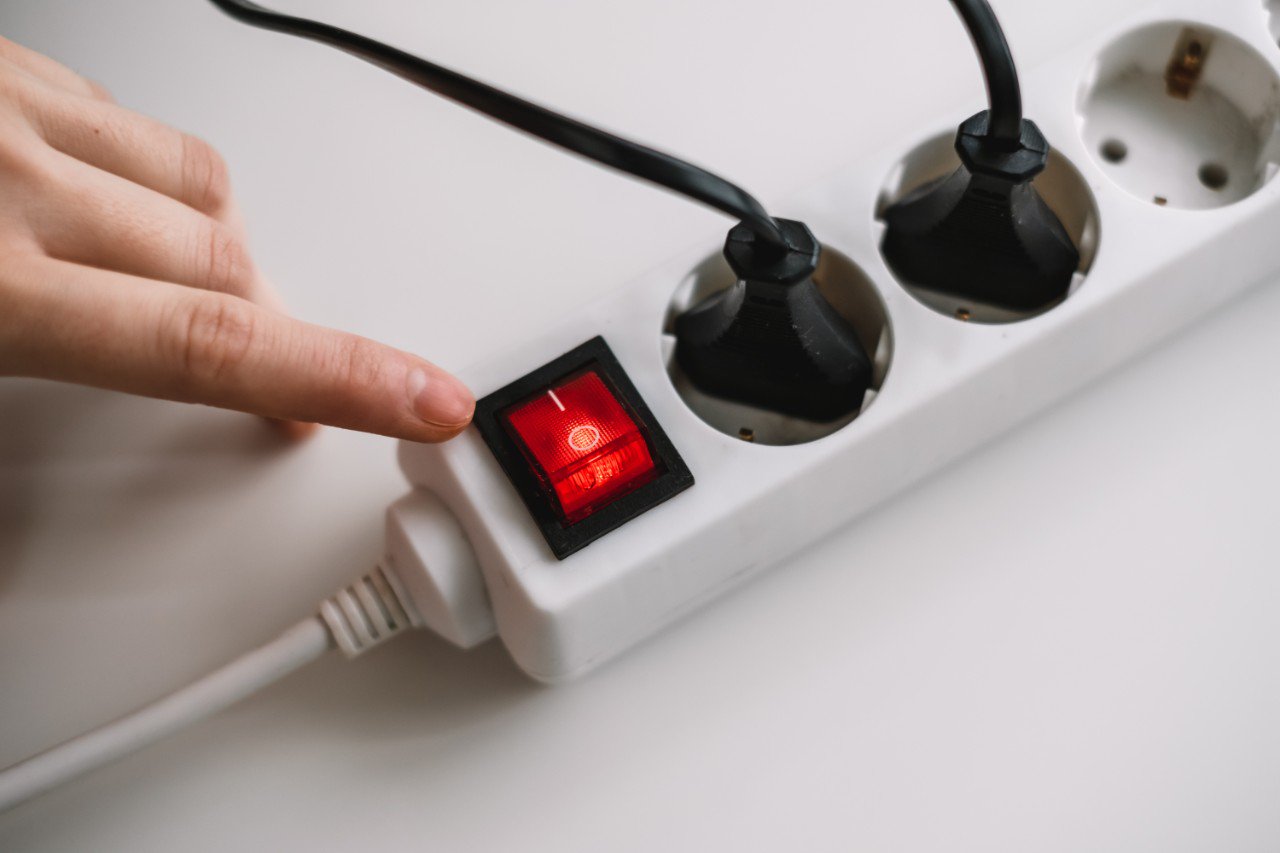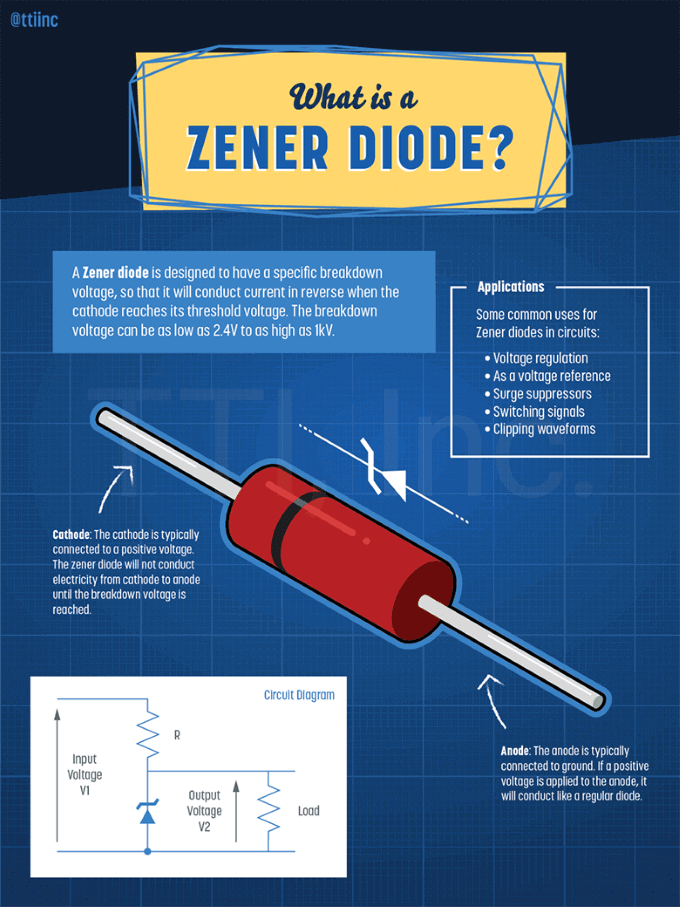Definitions, terms & abbreviations are located at the bottom of the page.
Pronounced zee·nr dai·owd
Zener diodes are semiconductor devices that allow current to flow in both directions but specialize in current flowing in reverse. Also known as breakdown diodes, Zener diodes are the most common electronic components used as stable voltage references for electronic circuits.
American physicist, Dr. Clarence Melvin Zener, first described the electronic properties of Zener diodes while researching the breakdown mechanisms of semiconductor materials. As a theoretical physicist at Bell Labs in New Jersey, he wrote a research paper later published in 1934, identifying a type of electrical breakdown later known as the Zener effect. These specific processes were named after him in the years afterward in his honor.
Zener Diode Infographic
Printables
Download Letter Size (8.5"x11")
Download Poster Size (18"x24")
Zener Diodes Functionality
Current going across the terminals in reverse bias (backward) is called the Zener effect. When voltage potential is met, this causes the Zener voltage (Vz)/breakdown voltage. Zener diodes uniquely consist of a heavily doped P-N junction that allows current to flow in reverse when reaching Vz. A well-defined Vz can conduct current continuously in reverse bias without getting damaged. Current then increases to a maximum level determined by a series resistor and stabilizes, remaining constant over a range of applied voltages. Therefore, Zener diodes are applicable for use as voltage regulators.
A Zener diode operates within the normal range of forward bias, with a turn-on voltage between 0.3V and 0.7V. When connected in reverse bias, the current flows backward, thus causing a small leakage of current to flow. As the reverse voltage increases to the arranged Vz, current flows throughout the diode. Current increases to a maximum decided by the series resistor and then stabilizes to remain constant over a range of applied voltages.
Zener diodes have two breakdown effects. Knowing these two effects help with understanding their functionality. First is the Zener effect, prevalent in voltages below 5.5V and involves a tunneling effect to cause the breakdown. The second is the avalanche breakdown or impact ionization which occurs in voltages above 5.5V. These breakdowns both result in the same behavior, and they do not require different circuitry, but each does have a different temperature coefficient. The Zener effect has an anode (negative) terminal temperature coefficient, while the avalanche has a cathode (positive) terminal temperature coefficient. Both temperature effects are almost equal to 5.5V. They cancel each other out, making Zener diodes rated at around 5.5V and stable over a wide range of temperature requirements.
Think of a Zener diode like two diodes in parallel, facing opposite directions. The voltage that's forward bias in a Zener diode has a voltage drop of 1V needed for the diode to turn on for the current to flow. The forward voltage is forward biased. The current flowing backward is considered the Zener voltage or reversed biased due to its properties. An example of the Zener voltage is 3.3V. For the current to flow across the diode, the current must maintain at least a minimum of this voltage. Having a predictable voltage drop makes Zener diodes not only useful as voltage regulators, but a correctly set Zener diode may limit the voltage of other devices.

Common Zener Diode Specifications
- Current Iz (max): Maximum current at the rated Zener Voltage (Vz – 200μA to 200A).
- Current Iz (min): Minimum current value required for a diode to break down.
- Forward Bias: Voltage going across a diode that allows the current to flow easily in one direction.
- Power Rating: Denotes the maximum power the Zener diode can dissipate and is a product of the diode voltage/current flowing through it.
- Reverse Bias/Zener Effect: Voltage going across a diode in the opposite direction of forward bias, this particular voltage doesn't cause any detectable current to flow, changes AC to DC current, and manipulates other electronic signals.
- Temperature Stability: Diodes around 5V have the best stability.
- Voltage Tolerance: Typically ±5%
- Zener/Breakdown Voltage (Vz): This is the minimum voltage that causes a portion of an insulator to experience a breakdown and become electrically conductive. Voltage ranges from 2.4V to 200V and can go up to 1kV, while the maximum for the surface-mounted device is 47V.
- Zener Resistance (Rz): The resistance exhibited to the Zener diode.
Key Terms
- Avalanche Breakdown: Occurs when a high reverse bias voltage increases the electric field and further expands up the depletion region.
- Diodes: A two-terminal electronic component that conducts current in one asymmetrical direction with a low resistance of zero and a high infinite resistance in the other.
- Doping: The process of adding certain chemical elements which contain small impurities to a semiconductor to change its electric conductivity.
- Electrical Breakdown: This process occurs when insulated electrical materials exposed to high voltage become an electrical conductor and electric current flows through it. It's also known as a dielectric breakdown.
- Impact Ionization: The process in a material by which one energetic charge carrier can lose energy by the creation of other charge carriers.
- P-N Junction: A boundary or interface between two types of semiconductor materials, p-type (positive), and the other is n-type (negative), which are both inside a single crystal of semiconductor. The "p" side contains an excess of holes, while the "n" side contains an excess of electrons in the outer shells of the “n” side’s electrically neutral atoms.
- Semiconductors: A material product with an electrical conductivity value falling between a conductor such as a metallic copper and an insulator, such as glass.
- Tunneling: A purely quantum-mechanical process in which a microscopic particle can penetrate a potential barrier even when the energy of the incident particle is lower than the height of the barrier.
Key Abbreviations
- A: Anode is a positive current
- IF: Intermediate Frequency
- IR: Maximum Reverse Voltage
- lZ: Current Carrying Capacity
- K: Cathode is a negative current
- kV: Kilovolt is a unit of electrical potential
- R: Resistance
- V: Volts is a unit of electrical potential
- Vf: Maximum Forward Voltage
- VR: Maximum DC Reverse Voltage
- Vz: The Zener Voltage
- μ: Prefix for Micro
- μA: A Microampere is a unit of electrical current, equal to one-millionth of an ampere
Zener Diode Examples & Applications
- Surge Suppressor: An electrical device, also known as a surge protector, that is used to protect equipment against power surges and voltage spikes while blocking voltage over a safe threshold of approximately 120V.
- Switching Signals: An output signal switching device (or OSSD) is an electronic device in a machine's safety system that provides a coded signal that, when interrupted due to a safety event, signals the machine to shut down. This helps avoid a stray signal operating a machine during unsafe conditions.
- Voltage Reference: An electrical device that produces a fixed (constant) voltage regardless of the loading on the device, power supply variations, temperature changes, and the passage of time.
- Voltage Regulator: When the load voltage equals the Zener voltage of the diode, the series-connected resistors limit the current through the diode. This serves to regulate voltage when there is an excess amount of voltage while the diode is conducting. The diode generates noise which can be suppressed by adding a large value decoupling capacitor across the diode.
- Voltage Shifter: When applied to a circuit with a resistor, Zener diodes act as voltage shifters. The circuit lowers the output voltage equal to the diodes’ Zener voltage.
- Waveform Clipper: Reshapes a signal and prevents voltage spikes from affecting circuits connected to a power supply.
 Zener diodes applied to an electronic circuit board
Zener diodes applied to an electronic circuit board
 Power strips are used as surge protectors
Power strips are used as surge protectors
 Smartphones contain voltage regulators
Smartphones contain voltage regulators
Application examples that utilize Zener diodes are smartphones which contain voltage, voltage reference devices like digital multimeters, and power strips which are surge suppressors. Electronic circuit boards contain Zener diodes and are used to shift voltage, be a waveform clipper, and switch signals in a variety of devices involving Bluetooth technology, televisions, transmitters that produce radio waves, and more.
In Conclusion
Some notable manufacturers of Zener diodes include Nexperia, Vishay, ROHM, and Toshiba. These manufacturers produce Zener diodes for use in a variety of electronic components specializing in industries like consumer electronics, automotive, telecommunications, computing, industrial, and more. Zener diodes are small components that play a big role in the devices that serve industry professionals and everyday consumers and they will continue to do so for years to come.
Looking to buy a particular Zener diode?
If you have any questions, call TTI’s customer support at (877) 645–4884.
Click here to see all the Zener diodes that TTI sells.
- Search all Nexperia Zener Diodes
- Search all Vishay Zener Diodes
- Search all ROHM Zener Diodes
- Search all Toshiba Zener Diodes
